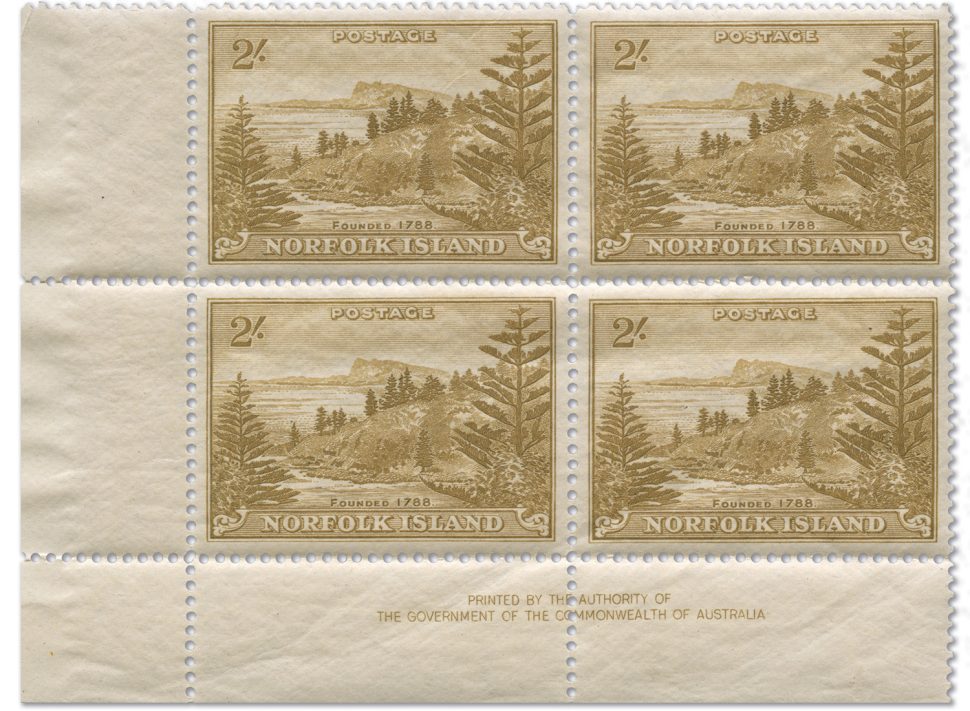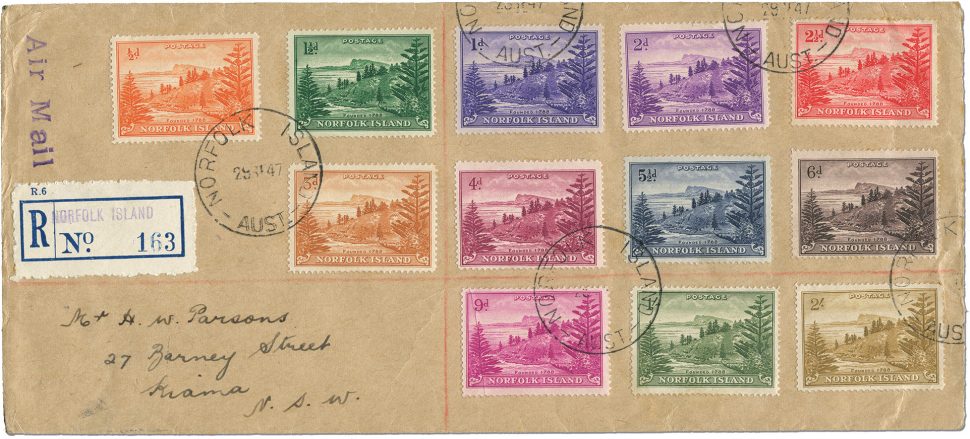In 2016, Australia Post will release its first ever stamp issue for Norfolk Island, following the closure of the Norfolk Island postal service after a long and proud history. The change forms part of a Commonwealth government program that will see a broad range of Commonwealth laws apply to this Australian external territory from 1 July 2016.
The Norfolk Island stamp issues released by Australia Post will be sold in the same way as those produced for other Australian territories (Australian Antarctic Territory, Christmas Island and Cocos (Keeling) Islands), in that the stamps can be used in Australia as well as within Norfolk Island. Information on updating standing orders to receive Norfolk Island stamps is at the base of this article.
The first stamp issue will focus on two iconic seabirds of Norfolk Island, as suggested by Parks Australia – the Red-tailed Tropicbird and the Masked Booby. In the lead-up to the first stamp issue, Australia Post will also release six prepaid postcards of various Norfolk Island scenes, using images by local photographer Brett Kytola.
We thought it would be timely to take a look at some of the history of Norfolk Island stamps. Interestingly, while Norfolk Island stamps have never previously been valid in Australia, Norfolk Island used Australian stamps as valid postage between the nineteenth century and 1947.
Australia Post owns a large collection of Norfolk Island stamps and postal history, put together by the late Ray Blinman, which was purchased in 1995. Among these stamps are many of the Ball Bay stamp series, behind which lies an interesting story.
A tale of war …
When Norfolk Island came under Commonwealth control in 1914, it became part of the Australian postal system. However, it was decided in 1937 that a separate postal authority would be established on Norfolk Island. The first issue would be a set of stamps featuring Ball Bay on Norfolk Island’s south-east coast. The design had been prepared by the Note Printing Branch in Melbourne early in 1938, based on a photograph taken by local resident Roy Bell.
The stamp was designed and engraved by Frank Manley, though the design process was an incredibly slow one. In those days, the stamp design had to be approved by the Prime Minister’s Department. It took until April 1939 for production to receive the green light, and the engraving wasn’t approved until January 1940. The Australian Stamp Monthly had made an announcement in January 1940 that the stamps would be available in three months’ time and printing began in earnest.
However, World War II soon intervened. The Note Printing Branch was told to keep hold of their stamp stocks until administrative arrangements had been made in relation to the Norfolk Island postal authority. No decision on the matter was made for the duration of the war.
… And a tale of destruction
Even once it was decided, in February 1946, that the Norfolk Island Ball Bay stamp issue would finally be released, there were further problems. When the postal authority looked at the Ball Bay stamps printed back in 1940, they realised the colours used no longer complied with the UPU Colour Code (the standard colours used by member countries of the Universal Postal Union), for certain stamp denominations commonly used in the international postal system.
The stamps also had the old “John Ash” imprint (the name of the Commonwealth stamp printer of the time) in the sheet margins, which had become, also in 1941, the “By Authority” imprint. Plus, the denomination mix was no longer suitable.
Since December 1941, a halfpenny war tax applied to each postal article, lifting the amount of postage involved. This meant the entire issue had to be reprinted –almost 590,000 stamps!
By the time this occurred, it meant it wasn’t actually until 10 June 1947 that Norfolk Island established its own postal system and issued the Ball Bay stamps.
The Ball Bay stamp issue 1947
The full series of 12 stamps issued in June 1947 (and their now-compliant colours) comprised: ½d orange, 1d blue-purple, 1½d emerald, 2d mauve-lake, 2½d red, 3d tan-brown, 4d claret, 5½d indigo, 9d magenta, 6d rosine, 1s deep green and 2s sienna.
Almost two decades of Ball Bay stamps
Perhaps because of the effort that went into their initial production, the stamps were in circulation for 16 years, until 1963 in fact (including various reprints and colour changes for two values). There was a change in printing techniques in the intervening years – from flat-bed recess printing to a larger rotary recess printing press after 1956.
The four stamps printed on the rotary press in 1956–57 are on thinner paper and the colours appear deeper. The paper used also varied between the 1947 issue and later issues. In the original 1947 Ball Bay issue, an off-white, surfaced, non-watermarked paper was used. The result was a slight tint of ink in the white margins. Afterwards, a whiter paper lessened the appearance of tinting.
An interesting twist ...
The story doesn’t end there. Despite the destruction of the 1940 Ball Bay stamps around 1959, examples of the original 1940 print run appeared for sale in England.
The theft of these stamps was part of a broader holding of Australian stamps that contained faults of some kind, such as perforation errors, and were meant for destruction. These stamps are, of course, highly prized by collectors!
Updating standing orders for Norfolk Island stamps
If you're a collector with an existing standing order, you can amend this to receive Norfolk Island stamp issues. This can be done by telephone, fax or in writing:
Philatelic Mail Order Bureau
Reply Paid 86359
GEORGE STREET, QLD 4003
Australia
Phone: FREECALL 1800 331 794 or +61 3 9887 0033 (overseas customers)
Fax: 03 9887 0236 or +61 3 9887 0236 (overseas customers)
This article was produced at the time of publication and will not be updated.




